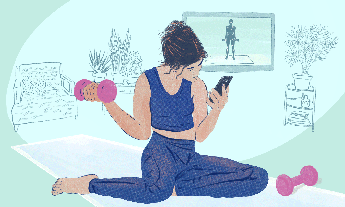
Many people in our industrialized world have what I call “busyness delusion,” or the mistaken belief that we are busier than we really are.
This may be difficult to accept, but many of us think we work more hours than we actually do.
If you immediately read this and thought, “I really am working too many hours. It’s not in my head,” I understand. I thought the same thing. Bear with me.
Since the mid-1960s, researchers have conducted time-use surveys in the US and have a pretty accurate understanding of average work schedules. Men today work about 12 hours less per week than they did in the 1970s. Women work more, partly because more women have full-time jobs than they did 50 years ago — but their unpaid labor has dropped by double digits. When working mothers kept time diaries for several weeks, they found they had much more time with their children than they thought.
Regardless of whether you’re working excessive hours or not, believing that you are short on time has real, damaging effects. Keeping an eye on the clock, even subconsciously, can lead to a sharp drop in performance.
Research shows that when you are highly aware of time passing, it makes you less compassionate toward others. What’s more, it can interfere with your ability to make rational decisions.
Because of this, feeling pressed for time can lead you to make bad choices about how you use it, and this can quickly become a vicious cycle. Having no clear understanding of how you spend your time can leave you feeling more overwhelmed, which can cause you to make decisions that lead to more stress and anxiety, which feeds the sense that you’re pressed for time and leads to your feeling even more overwhelmed.
An understanding of how your hours are spent is known as “time perception.” People who have high time perception and are very aware of their schedules actually tend to set aside more time for leisure. These people allow for time to contemplate and reflect, which gives them the sense that they have more time.
On the other hand, people who have low time perception spend more time watching TV or lingering on social media sites, and they often report feeling overwhelmed. Sound familiar?
Increasing my time perception has made a radical difference in my life. This one small change — being more aware of what you do in your waking hours — could have a cascade of benefits for you, too.
It may leave you with a sense that you have more time to take care of your needs and your desires. As it turns out, that feeling may be better for you than a raise in pay.
A 2009 study showed that after controlling for income, if you make someone believe they have time to spare, they feel healthier and happier. You’ll notice I said “make someone believe they have free time” — it’s a feeling, not necessarily a reality. No one in the experiment actually found more free time; participants just felt they had more.
Of course, some people have to work several jobs in order to keep a roof over their heads and food on the table. It has not been long since that was me. For anyone in that situation, a sense of time affluence may be out of reach right now.
Here’s how to sharpen your time perception.
Step 1: Track your time
Begin by keeping a diary and tracking your activities. Be honest! If you spent a half hour on Twitter, note that down. If you spent 20 minutes looking at shoes online, write that down too. No one will see this diary but you, and the more honest you are, the more helpful this exercise will be.
Once you know how much you’re working, how much you’re spending on social media, and how much you’re spending on leisure, you can begin to ask yourself some important questions, like: How much time do I want to spend on social media or email? Do I want to exercise every day? How much time should it take to eat dinner?
Use the answers to these questions to create guidelines for yourself.
I spent three weeks keeping a diary of my time. To do this, I bought a notebook and divided each day into half-hour chunks. Every few hours, I’d write down what I’d been doing.
At the end of three weeks, I realized I spent about two-and-a-half hours on email every day and a couple more hours reading Facebook posts and tweets. Weekly, I spent more than three hours idly shopping on the internet.
I’m only awake for about 16 hours, so it was a shock to discover that more than one-third of my day was spent doing mostly useless things online. Instead of reading a book while I sat in waiting rooms or on the train, I’d refresh my Instagram feed and “like” my friends’ posts. That’s not how I wanted to spend my days, but I’d had no idea that’s what I was doing with my time.
Step 2: Make a schedule
I decided that I wanted to spend no more than 90 minutes a day on email and social media. (Since then, I’ve pared it down to an hour.) To accomplish that, I knew I’d have to make drastic changes.
I created two ideal schedules, one for gym days and one for the rest. You may find it more useful to create a schedule for weekdays and another for weekends.
I asked myself: What’s the ideal use of my time on a daily basis? I created a list of the things I wanted to do every day, plus the things I had to do, then spread them over my 16 waking hours. Here’s what those schedules look like:
Gym Days
7:00 Wake/take care of the dog/dress
7:30 Walk the dog
8:30 Gym
9:30 Shower
9:45 Meditate
10:00 Email and social media
10:30 Write/work
12:30 Lunch
1:00 Short walk
1:30 Write/work
3:30 Free time and meditate
5:30 Walk the dog
6:30 Dinner
7:30 Free time
9:00 Bath or self-care
10:00 Bed
Non-Gym Days
7:00 Wake/take care of the dog/dress
7:30 Walk the dog
8:00 Meditate
8:30 House chores and errands
9:30 Email and social media
10:00 Write
12:30 Lunch
1:00 Short walk
1:30 Write
3:30 Free time and meditate
5:30 Walk the dog
6:30 Dinner
7:30 Free time
9:00 Bath or self-care
10:00 Bed
I don’t see these schedules as restrictive but supportive; they are merely suggestions. Often, I have to do interviews or meet up with friends, and that means my day changes. If I spend 40 minutes on social media some days instead of 30, I don’t sweat it and my dog doesn’t always get three walks a day. (Sometimes she gets four.)
If I’m traveling, these schedules change more, yet I’ve found that the basic underpinnings remain the same. I nearly always find time for the activities listed here, even if they occur at very different times.
This is an ideal schedule, remember, and ideal is rarely the same as real.
Since creating these schedules, I check email once an hour and generally limit my social media time to one hour a day. Sometimes, a couple hours go by before I realize that I haven’t looked at my inbox, which was unheard of in past years.
On weekends, I often forget about email completely after I check it once in the morning. I can’t even describe how liberating that is and how relaxing. I installed an app on my phone that limits my access when it’s turned on. If I start the app and then try to unlock my phone, it says “Really??” and I quickly put it down.
I printed out my schedules and hung copies in my office. After following them for a few weeks, I was surprised to discover that I had plenty of time to do everything I wanted to do, with hours to spare.
It was a powerful moment for me. When I truly understood that my work was not out of control or unmanageable, a tangible wave of relief swept through my body. I have enough time!
Adapted from Do Nothing: How to Break Away from Overworking, Overdoing, and Underliving copyright © 2020 by Celeste Headlee. Used by permission of Harmony Books, an imprint of Random House, a division of Penguin Random House LLC. All rights reserved. No part of this excerpt may be reproduced or reprinted without permission in writing from the publisher.
Watch her TED Talk here:














